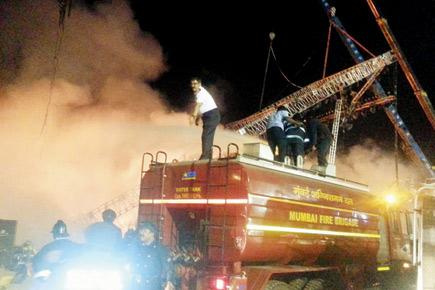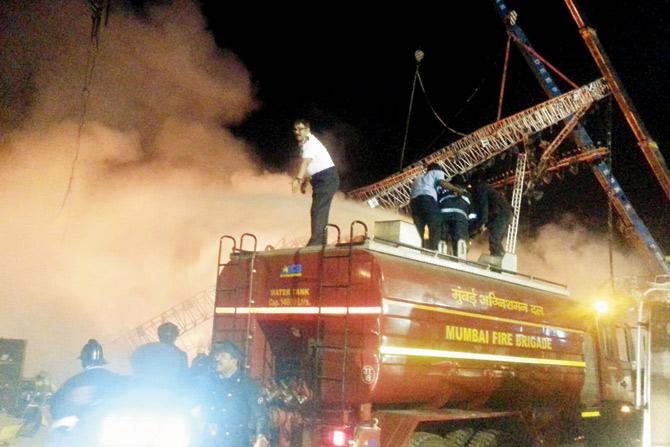The Mumbai fire brigade has submitted its report on the Make in India fire at Girgaum Chowpatty, stating that the likely cause was a ‘Defective Electric Circuit

CFO P S Rahangdale said he was among the first on the ground to respond to the crisis with an extinguisher. File pic
The Mumbai fire brigade has submitted its report on the Make in India fire at Girgaum Chowpatty, stating that the likely cause was a ‘Defective Electric Circuit’. However, mid-day spoke to an expert who found several loopholes in the fire department’s version, to which fire chief Prabhat Rahangdale gave his responses.
ADVERTISEMENT

CFO P S Rahangdale said he was among the first on the ground to respond to the crisis with an extinguisher. File pic
No fire audit
Fire report states:
The Mumbai fire brigade’s report on the Girgaum Chowpatty fire makes no mention of any fire audit conducted before the event. The only mention is of an No Objection Certificate (NOC) of fire safety measures filed on February 11. On February 13, a second inspection was undertaken jointly by the divisional fire officer, a representative from the organiser Wizcraft, and officials from the BMC D-ward, disaster management department, local police and the Confederation of Indian Industry. Following this, six lapses were pointed out in writing to the commissioner of police and also to the organiser.
Expert questions:
Apart from the two letters, no other audit or compliance report was furnished by the fire department. It is surprising that even after a copy of the NOC was submitted on February 11, and a written joint inspection report was submitted two days later, neither the fire brigade nor the police department bothered to check whether the organiser complied with the instructions given to them. Experts who went through the reports claim that merely writing a letter and raising objections does not amount to an audit. This step should not have been skipped, especially when the event was to be attended by important dignitaries. Experts also pointed out that pyrotechnics also count as fireworks, so they shouldn’t have been allowed at the stage area.
Fire chief defends:
Chief Fire Officer Prabhat Rahangdale. However, insisted that the NOC given by his department was as good as a fire audit. A second inspection was also carried out two days after the NOC and lapses were pointed out to the organisers in writing. To achieve ease of business, the authorities have moved to a single window clearance system, and under this, it is obligatory for the event organisers to produce self-compliance to the appropriate agencies (traffic, local police, ward office etc). Firecrackers that were close to the stage were shifted towards outside the barricades by the organisers, as per our recommendation. Also during the reinspection, no LPG cylinders were seen at the venue.
Instructions ignored
Fire report states:
The Fire NOC, dated February 11, clearly states under point number 13 that ‘Display of Fire Crackers shall not be allowed inside or near the pandal’. In addition, the report from the February 13 joint inspection clearly highlights six instructions, mainly to remove all combustible material away from the stage, to ensure stage construction material is made fire retardant and to replace expired fire extinguishers at the site (see box).
Expert questions:
This cannot be called a fire audit, as these were merely observations made by the divisional fire officer in a joint inspection the day before the event. None of the concerned authorities, to whom the letter was marked, had bothered to check for compliance before the event started on February 14. Had they done so, the disaster could have been averted.
Fire chief defends:
As far as fire department is concerned, we have adhered to the procedure.
Since firecrackers were objectionable, they were shifted outside the venue. Firecrackers are different from pyrotechnics, which were allowed. The requirement for fire retardant materials was stated in the NOC, and it was the duty of the organisers and set designers to carry out self-compliance. Violation of the same is an act of negligence on their part.
Were electricals certified?
Fire report states:
Point number 18 in the Fire NOC reads: “The entire electrical installation shall be carried out by licensed electrical contractors and a certificate to that effect shall be obtained from him [said contractor].”
Expert questions:
It was mandatory for the electrical contractor to get the electrical circuits rechecked at the venue before the start of the event by competent government agencies. The cause of fire has been ascertained as ‘defective electric circuit’, but the fire report is silent on whether any such certification was done.
Fire chief defends:
This requires self-compliance; the certificate was expected to be submitted by the said contractors/organisers.
Cause of fire
Fire report states:
The fire department stated that Defective Electric Circuit (DEC) was the likely cause of the fire. Officials went through several video clippings of the fire and recorded statements of various witnesses, including fire officials, who stated that the electrical contractor had installed 22 generator vans and provided backup switches/gears and various types of cables and panels and supplying electric power from the BEST meter to the main stage and hangers for various equipment. The electrical cables, wires, installations were laid down around the stage in a haphazard manner. BEST Undertaking’s deputy chief engineer, S K Patil, stated that after the fire, a fuse installed at tower no 6 was found to have blown out. Therefore, there is every possibility that a spark from the electrical wirings came in contact with combustible materials underneath the stage. Hence supposed cause of fire is derived as DEC.
Expert questions:
The licensed electrical contractor Ismail Babu Shaikh, in his statement, had nowhere mentioned any indication of an electric short circuit. He also did not mention whether he had observed any power failure due to the alleged electric short circuit. Just like the fire department’s report, the electrical contractor’s statement also does not mention whether the circuits were rechecked by competent authorities approved by the state.
Moreover, BEST official Patil’s statement does not clarify whether the fuse box blew out before or after the fire. Neither has he mentioned the location of tower 6 in relation to the stage, where the fire broke out. Not a single witness has come forward acknowledging any short-circuit.
Fire chief defends:
I was an eyewitness to the fire and was among the first on the ground to respond to the crisis with an extinguisher. Tracing the manner in which the fire spread, we decided to probe circumstantial evidence, witness accounts, the possibility of defective pyrotechnics and we also reassessed all statements from fire officials, finally concluding that the fire was due to DEC.
The highly combustible materials only aggravated the fire, aided by strong wind.
6 instructions
>> There will be no display of fire crackers behind the stage and combustibles will be kept at a distance of 30 feet
>> The material used for temporary erection of stage shall be of non-combustible type or treated with fire retardant paint
>> The combustible materials stored underneath the stage shall be removed immediately
>> Paints, adhesive materials stored for decoration shall be removed immediately
>> Ten carbon dioxide cylinders (compressed) noticed near the stage shall be shifted immediately
>> Expired fire extinguishers shall be replaced immediately and trained personnel shall be deployed to use them
 Subscribe today by clicking the link and stay updated with the latest news!" Click here!
Subscribe today by clicking the link and stay updated with the latest news!" Click here!






